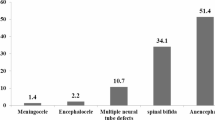Abstract
Purpose
Primary prevention by periconceptional folic acid supplementation can significantly reduce the risk of neural tube defects. EUROCAT, the European network of population-based registries for the epidemiologic surveillance of congenital anomalies, lacks sufficient data on the birth prevalence of neural tube defects in Hungary before and after the promotion of primary prevention by folic acid. Our aims were to compare the birth prevalence of neural tube defects (myelomeningocele, anencephaly and encephalocele) over two 12-year periods in South-Eastern Hungary. Further aims were to compare our data to those ones in other areas in Europe.
Methods
Data were collected from the databases of the Department of Hungarian Congenital Abnormality Registry. The total and live birth prevalence rate of neural tube defects were calculated and compared over 1980–1991 and 1994–2005. In addition, the trends in the total birth prevalence, the number of live births and terminations for and stillbirths with neural tube defects were analysed throughout the period of 1994–2005.
Results
A significant decline was found in the total and live birth prevalence of myelomeningocele, anencephaly and encephalocele over 1994–2005 compared to the period of 1980–1991. The total birth prevalence of neural tube defects, however, showed a trend of increase after 1994, with declining number of live births and increasing number of terminations for neural tube defects.
Conclusion
Public health measures are warranted in order to replace termination of pregnancy with primary prevention in South-Eastern Hungary.



Similar content being viewed by others
References
Aicardi J (2009) Malformations of the central nervous system. In: Diseases of the nervous system in childhood, 3rd edn. Mac Keith, London, pp 41–102
Au KS, Ashley-Koch A, Nothrup H (2010) Epidemiologic and genetic aspects of spina bifida and other neural tube defects. Dev Disabil Res Rev 16:6–15
Bognár M, Ponyi A, Hauser P, Müller J, Constantin T, Jakab ZS, Schuler D, Garami M (2008) Improper supplementation habits of folic acid intake by Hungarian pregnant women: improper recommendations. J Am Coll Nutr 27:499–504
Boltshauser E, Schneider J, Kollias S, Waibel P, Weissert M (2002) Vanishing cerebellum in myelomeningocele. Eur J Paediatr Neurol 6:109–113
Boulet SL, Yang Q, Mai C, Kirby RS, Collins JS, Robbins JM, Meyer R, Canfield MA, Mulinare J, National Birth Defects Prevention Network (2008) Trends in the postfortification prevalence of spina bifida and anencephaly in the United States. Birth Defects Res A Clin Mol Teratol 82:527–532
Czeizel AE (2009) Periconceptional folic acid and multivitamin supplementation for the prevention of neural tube defects and other congenital abnormalities. Birth Defects Res A Clin Mol Teratol 85:260–268
Czeizel AE, Dudás I (1992) Prevention of the first occurrence of neural tube defects by periconceptional vitamin supplementation. N Engl J Med 327:1832–1835
De Wals P, Tairou F, Van Allen MI, Uh SH, Lowry RB, Sibbald B, Evans JA, Van den Hof MC, Zimmer P, Crowley M, Fernandez B, Lee NS, Niyonsenga T (2007) Reduction in neural-tube defects after folic acid fortification in Canada. N Engl J Med 357:135–142
Dolk H, Loane M, Garne E (2010) The prevalence of congenital anomalies in Europe. Adv Exp Med Biol 686:349–364
EUROCAT (1974) European Surveillance of Congenital Anomalies (EUROCAT). http://www.eurocat-network.eu/
EUROCAT (2009) EUROCAT Special Report: Prevention of neural tube defects by periconceptional folic acid supplementation in Europe. EUROCAT Central Registry, University of Ulster http://www.eurocat-network.eu/
Frey L, Hauser WA (2003) Epidemiology of neural tube defects. Epilepsia 44(suppl3):4–13
Heseker HB, Mason JB, Selhub J, Rosenberg IH, Jacques PF (2009) Not all cases of neural-tube defects can be prevented by increasing the intake of folic acid. Br J Nutr 102:173–180
Juranek J, Salman MS (2010) Anomalous development of brain structure and function in spina bifida myelomeningocele. Dev Disabil Res Rev 16:23–30
Mitchell LE (2005) Epidemiology of neural tube defects. Am J Med Genet C Semin Med Genet 135C:88–94
MRC Vitamin Study Research Group (1991) Prevention of neural tube defects: results of the Medical Research Council Vitamin Study. Lancet 338:131–137
Ramakrishnan U, Grant F, Goldenberg T, Zongrone A, Martorell R (2012) Effect of women’s nutrition before and during early pregnancy on maternal and infant outcomes: a systematic review. Paediatr Perinat Epidemiol 26(suppl1):285–301
Rankin J, Glinianaia S, Brown R, Renwick M (2000) The changing prevalence of neural tube defects: a population-based study in the North of England, 1984–96. Northern Congenital Abnormality Survey Steering Group. Paediatr Perinat Epidemiol 14:104–110
Rowland CA, Correa A, Cragan JD, Alverson CJ (2006) Are encephaloceles neural tube defects? Pediatrics 118:916–923
Sandor J (2007) Report on periconceptional folic acid supplementation for Hungary. http://www.eurocat-network.eu/content/NTD-Dec2007-Hungary.pdf
Srour M, Rioux MF, Varga C, Lortie A, Major P, Robitaille Y, Décarie JC, Michaud J, Carmant L (2011) The clinical spectrum of nodular heterotopias in children: report of 31 patients. Epilepsia 52:728–737
Stoll C, Dott B, Alembik Y, Roth MP (2011) Associated malformations among infants with neural tube defects. Am J Med Genet A 155:565–568
Vinck A, Nijhuis-van der Sanden MWG, Roeleveld NJA, Mullaart RA, Rotteveel JJ, Maassen BAM (2010) Motor profile and cognitive functioning in children with spina bifida. Eur J Paediatr Neurol 14:86–92
Yi Y, Lindemann M, Colligs A, Snowball C (2011) Economic burden of neural tube defects and impact of prevention with folic acid: a literature review. Eur J Pediatr 170:1391–1400
Acknowledgments
Dr László Sztriha has been funded by a Marie Curie International Reintegration Grant (MIRG-CT-2005-030967) within the 6th European Community Framework Programme.
Author information
Authors and Affiliations
Corresponding author
Rights and permissions
About this article
Cite this article
Szabó, N., Gergev, G., Valek, A. et al. Birth prevalence of neural tube defects: a population-based study in South-Eastern Hungary. Childs Nerv Syst 29, 621–627 (2013). https://doi.org/10.1007/s00381-012-1951-1
Received:
Accepted:
Published:
Issue Date:
DOI: https://doi.org/10.1007/s00381-012-1951-1




